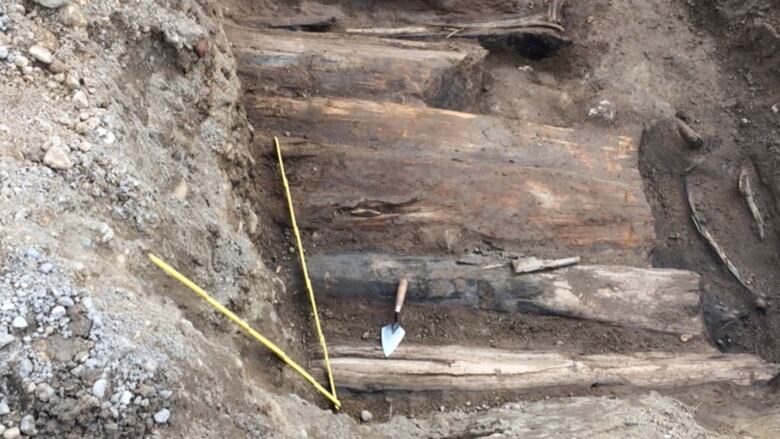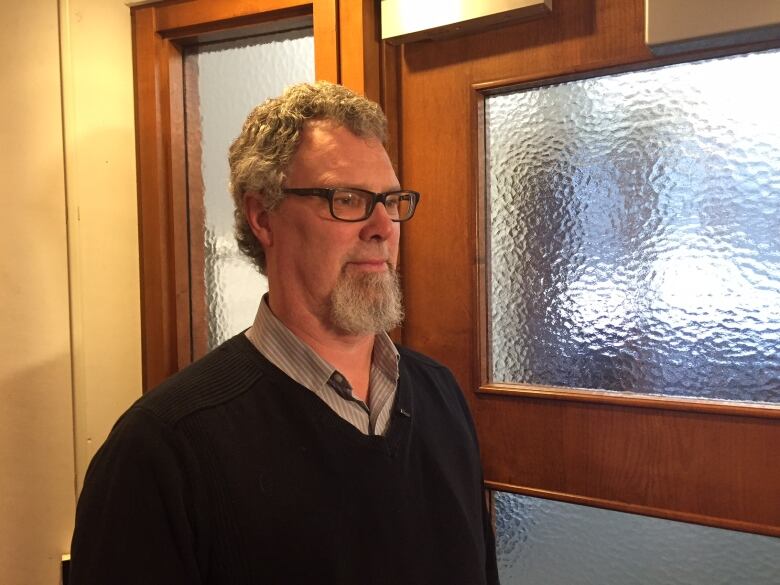Corduroy road likely one of Waterloo's first-ever European built roads
Archaeologist says discovery shows "King Street has been an economic thoroughfare for 200 years"

A corduroy road unearthed by construction crews on King Street in Uptown Waterloo dates back two centuries and is likely one of the first ever roads built by Euro-Canadian settlers in the region, according to a seniorarcheologist.
-
'Corduroy road' found under King Street worries Waterloo businesses
-
How 'corduroy road' discovery may affect uptown Waterloo LRT timeline
Charlton Carscallen said over the last two weeks, his teamhas been able to plotthe route of the corduroy road, whichhe saysruns north along King from William Street to the railroad tracks near Waterloo Town Square.

"We suspect itwas the Mennonites who built the road,"Carscallensaid, noting the white settlers who built it likelyadopted the technology from their former home inLancaster County Pennsylvania and brought it to Waterloo after the American Revolution.
"This particularcorduroyroad we believe was built somewhere between the late1790sand 1816," Carscallen said.
Mud route
Centuries ago, corduroy roads were a typical means for early European settlers toavoid horses, wagons and peoplegetting stuck in the mud.
They were built byfirst cutting a pathway throughthrough a forest and laying the timbersperpendicular to the route in order to provide a surface for wagons to travel over low-lying or soggy areas.
The corduroy road discovered along King Street wasa low-lying area whereLaurel Creek would haveonce flowed through what is now Waterloo's central business district.
"King Street has been a commercial thoroughfare for 200 years," Carscallen said, noting that todayjust as then, the route remains a critical link for the region's economy, as illustrated by the LRT project.
"There'ssome symmetry there," he said. "You have a transportation corridor that's serviced the region for 200 years and is going to continue to."
"The urgency of the project has been impressed upon me," saidCarscallen,who notes the corduroy roaditself will be documented and, with approval from the province, eventually removed from the path of the new LRT.
"The city museum has asked for some pieces for their displays," he said. "But we are talking about logs that have been sitting wet for 200 years, so most of them will be removed and disposed of."

Expect delays
What's good for history buffs isn't necessarily good for the bottom line of neighbourhood businesses. Provincial law requires construction to grind to a halt any time workers suspect they've found a site of historical significance, so that the find can be properly inspected.
The unexpected bureaucratic hurdle could push the construction schedule past its November deadline and into the busy Christmas holiday shopping season, according to Avril Fisken, spokeswoman for the construction consortium in charge of building the LRT.
"We don't know the date we can proceed with construction,"Fiskensaid, noting archeologists are going as fast as they can. "They're working long hours, they're working through the weekends and working directly with the ministry to expedite the review request."
Fisken said the discovery has ledGrandlinqto juggle its crewsand shift the work focus tothe Caroline Street and Allen Street area, which isoutside thearcheologicallysenstivezone.
Grandlinqis also seeking an exemption to noise by-laws,Fisken said,so that construction crews can work longer hoursto make up for any delays caused by the historical find.












_(720p).jpg)


 OFFICIAL HD MUSIC VIDEO.jpg)
.jpg)



























































































